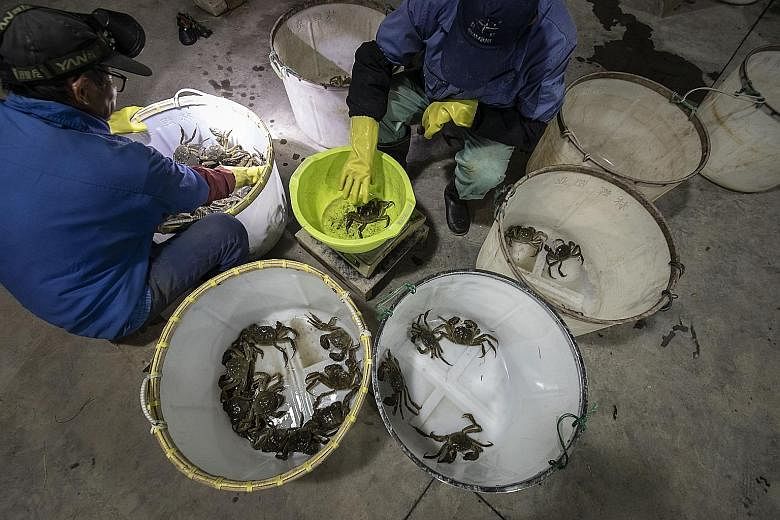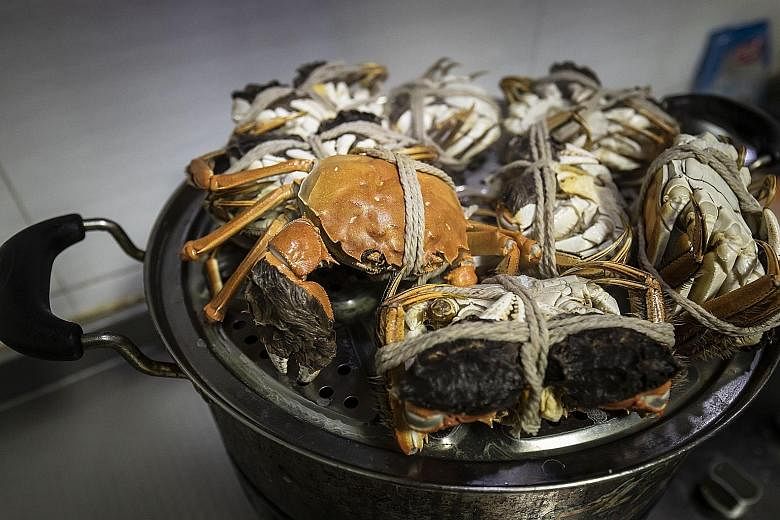SHANGHAI • Late in the afternoon on a recent weekday, workers at an aquaculture farm near Shanghai used long pincers to move 300g crabs from muddy ponds into small pools of freshwater. By morning, the crabs - their shells cleansed of dirt - will be packed into gift boxes and shipped to customers all over China.
These are no ordinary crustaceans: They are hairy crabs, a delicacy that can cost as much as 2,700 yuan (S$550) for a box of eight and can be purchased for only a few weeks in autumn. Prices for some of the most popular crabs have doubled compared with a year ago.
Even as China's economic growth slows amid Covid-19, the pandemic has been good for farm owner Ma Mingjun's business. In normal years, many Chinese give hairy crabs as gifts to special relatives, important customers or government officials, but now big-spending consumers who have not been able to shop in Paris or Milan are treating themselves to more home-grown luxuries.
"Almost all the hairy crabs in our pools have been reserved, much faster than last year," Mr Ma said. "To offset the frustration of travel restrictions, many customers are buying bigger crabs to share with their families."
Demand for hairy crabs in China was about 120 billion yuan last year and is expected to reach 150 billion yuan this year, according to consultancy AskCI Consulting. The bestseller this year costs 1,600 yuan per box, up from 800 yuan last year.
The seasonal delicacy is one of many pricey items gaining in popularity. LVMH and Kering reported mid-double-digit sales growth in China for the second quarter, while duty-free stores in the southern province of Hainan recorded a 167 per cent jump in sales during the week-long October national holiday.
Chinese travel stores - the type seen in airports and train stations - posted strong growth for Estee Lauder in the company's most recent quarter, chief executive Fabrizio Freda said on Monday.
That is in part because travel bans and quarantine requirements have forced the people of China to choose local destinations, said Ms Xu Ruyi, head of reports for North Asia at London-based consultancy Mintel Group.
"Many wealthy Chinese who used to 'buy buy buy' overseas are spending domestically," said Ms Xu. "High-income consumers are more resilient amid economic uncertainties and more willing to spend on something that can bring them pleasure in compensation for the hard year."
It is not just the pandemic helping demand for hairy crabs. Eastern China is a major production hub, and for many years most of the supply stayed in the Shanghai area. Consumers elsewhere often had difficulty getting them.
Now, with the expansion of logistics operations to service e-commerce operations like Alibaba Group and JD.com, farmers can more easily send crabs long distance. Cainiao, the logistics subsidiary of Alibaba, can deliver fresh crabs to domestic buyers within two days of receiving orders, and consumers in Singapore this year can get deliveries of crabs purchased on Alibaba's Taobao platform.
-
$550
Price of a box of eight hairy crabs. The seasonal delicacy can be purchased for only a few weeks in autumn.
$24.5b
Demand for hairy crabs in China last year; it is expected to reach 150 billion yuan (S$30.6 billion) this year.
$326
Price per box of the bestseller this year, double last year's 800 yuan.
Responding to concerns about seafood safety, farmers are also using livestreaming to reassure consumers of the cleanliness of their facilities. Influencers are doing on-location appearances and offering discounts.
Back at his farm near Shanghai, Mr Ma expects his crabs to reach their peak flavour early this month. "We'll work all night till dawn," he said. "Everyone deserves something nice in this difficult year."
BLOOMBERG


